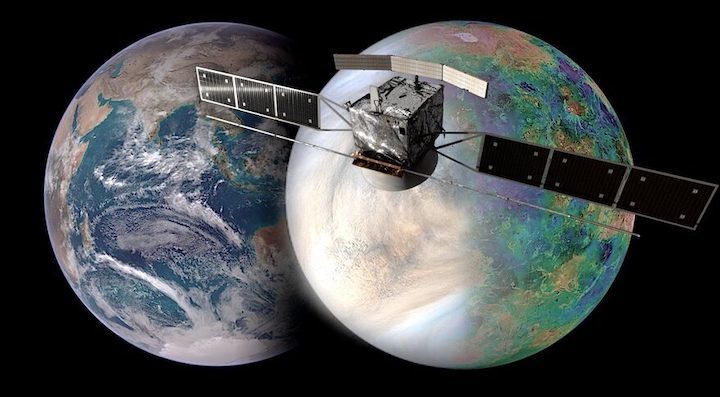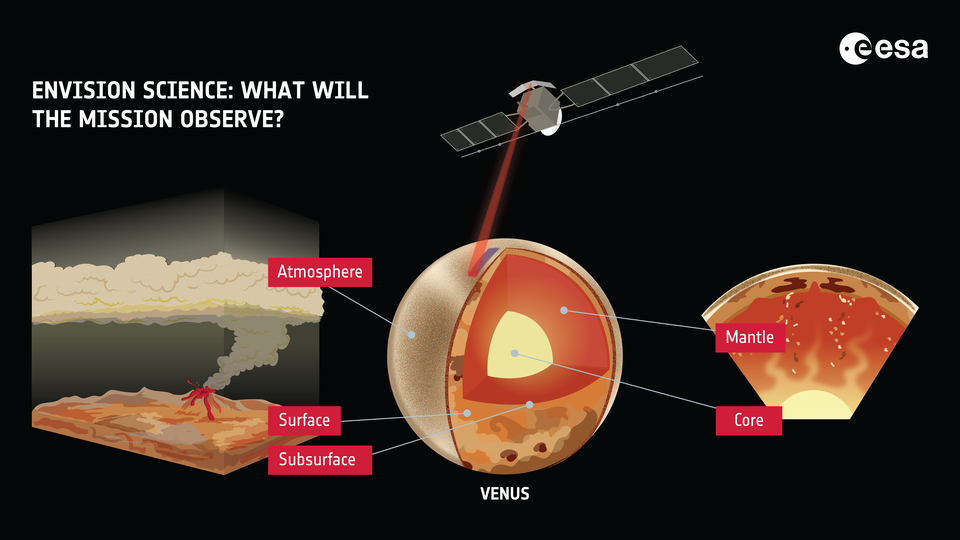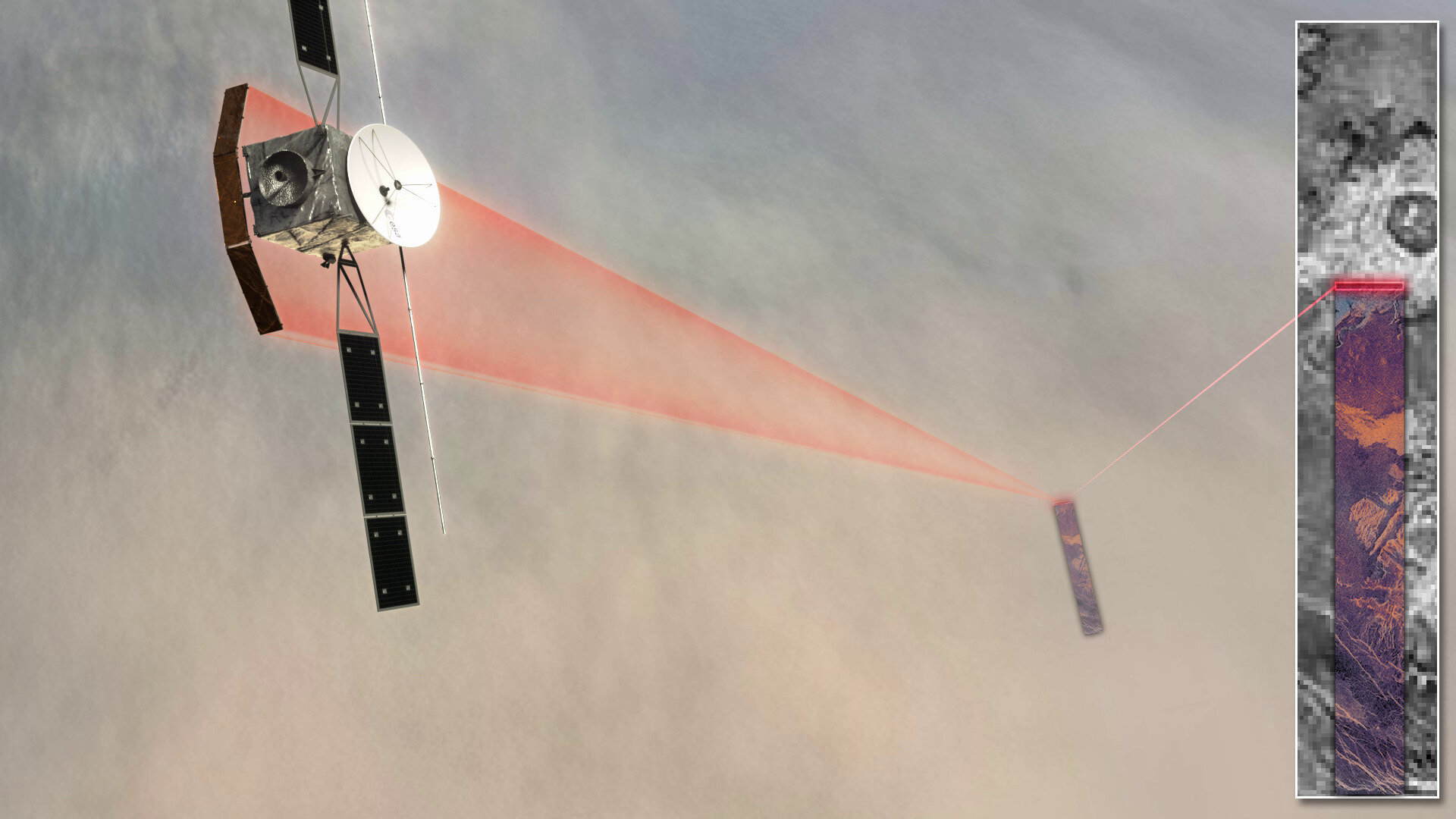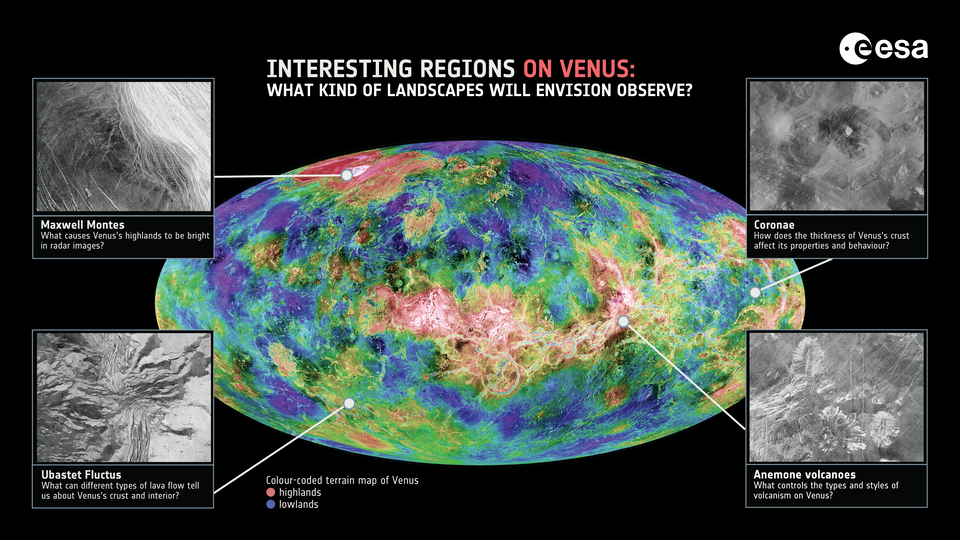12.06.2021

WASHINGTON — The European Space Agency has selected a Venus orbiter as its next medium-class science mission, just a week after NASA announced the section of two Venus missions of its own.
ESA announced June 10 that EnVision will be the agency’s next M-class, or medium-class, science mission. The orbiter will carry a suite of spectrometers, sounders and a radar to study the planet’s interior, surface and atmosphere.
Solar Orbiter will launch no earlier than 2031 on an Ariane 6 rocket. A baseline mission timeline included in a mission assessment study projected a launch during a one-month window that opens in late May 2032, arriving at Venus in August 2033. It would then use the planet’s atmosphere to aerobrake into its final science orbit by early 2035 for a four-year science mission.
EnVision was one of two finalists for the “M5” mission opportunity, along with Transient High-Energy Sky and Early Universe Surveyor (THESUS), an astronomy mission designed to look for transient events, in particularly gamma-ray bursts from the early universe. A third finalist, an infrared space observatory called SPICA that would have flown in cooperation with the Japanese space agency JAXA, was dropped from consideration in October 2020 because of cost issues.
ESA did not disclose the estimated cost of EnVision, but under ESA’s Cosmic Vision framework of science missions, M-class missions are intended to cost about 500 million euros ($610 million).
The selection of EnVision comes after NASA announced June 2 it selected two missions to Venus as part of its Discovery program of low-cost planetary science missions. DAVINCI+ will send a probe into the planet’s atmosphere to measure its composition and take images of one region of its surface. VERITAS is an orbiter that will perform radar and infrared emission mapping of the planet’s surface.
Neither the selection of the missions nor their timing was coordinated, but both NASA and ESA embraced what is effectively a complementary Venus exploration program. “A new era in the exploration of our closest, yet wildly different, solar system neighbor awaits us,” said Günther Hasinger, ESA director of science, in a statement. “Together with the newly announced NASA-led Venus missions, we will have an extremely comprehensive science program at this enigmatic planet well into the next decade.”
“EnVision leverages strengths in instrument development by both our agencies,” Thomas Zurbuchen, NASA associate administrator for science, said in the same statement. “Combined with NASA’s Discovery missions to Venus, the science community will have a powerful and synergistic set of new data to understand how Venus formed and how the surface and atmosphere changed over time.”
Both the U.S. and Europe are contributing to each other’s missions. The synthetic aperture radar on EnVision, called VenSAR, is being provided by NASA’s Jet Propulsion Laboratory. Ironically, the Italian space agency ASI and French space agency CNES are contributing to a similar radar on NASA’s VERITAS spacecraft, while the German space agency DLR will provide the infrared mapper for VERITAS.
EnVision is the fifth M-class mission ESA has selected as part of the Cosmic Vision program. The first, Solar Orbiter, launched in February 2020. Three others are in development: Euclid, a mission to map dark matter and dark energy to launch in 2022; Plato, an exoplanet search mission launching in 2026; and Ariel, an exoplanet characterization mission launching in 2029.
Quelle: SN
+++
Europe announces mission to study volcanoes on Venus
Mars is so last year. After NASA announced on 2 June that it will launch two probes to Venusbefore the end of the decade, the European Space Agency (ESA) today joined the party by selecting EnVision, another orbiter mission to our cloud-wrapped twin, for launch in 2031. The €610 million EnVision is the latest medium-class mission in ESA’s science program.
Compared with Mars, Venus has seen fewer visits from robotic spacecraft, but increased interest in climate change and Earth-like exoplanets has prompted researchers to ask why Venus is now a scalding hot greenhouse oven with a sulfuric acid atmosphere, after starting out so similarly to Earth. ESA’s Venus Express, which operated from 2006 to 2014, helped find hinds of ancient oceans and active volcanoes on the planet. Firming up that evidence is a key aim for EnVision, says lead scientist Richard Ghail of Royal Holloway, University of London. “The pattern of volcanoes tells us how the planet works,” he says.
Although there is some overlap in the aims and instruments of the NASA and ESA missions, Ghail says, “They do all fit together and in a sense, they are in the right order.” NASA’s VERITAS will provide a detailed global map of the planet’s topography, whereas DAVINCI+ will establish compositional “ground truth” by parachuting a probe through the atmosphere. EnVision will follow up by zooming in to understand how surface activity affects atmospheric dynamics, Ghail says.
Venus’s thick cloud cover means optical cameras can’t see much, but other wavelengths can penetrate the murk. EnVision will use an infrared spectrometer to seek out hot spots on the surface that could indicate active volcanoes. It will use radar to map the surface, looking for signs of lava flows. Ultraviolet and high-resolution infrared spectrometers will then look for water vapor and sulfur dioxide emissions, to see whether smoldering volcanoes are driving cloud chemistry today.
Ghail thinks space agencies have recognized that Venus deserves the same layered approach used on Mars, where global mapping missions have been followed by more targeted observations. “The discovery by Venus Express that there may be volcanism,” he says, “has made it a more interesting place to be.”
Quelle: AAAS
+++
Then There Were 3: NASA to Collaborate on ESA’s New Venus Mission

As a key partner in the mission, NASA provides the synthetic aperture radar, called VenSAR, to make high-resolution measurements of the planet’s surface features.
On June 10, 2021, the European Space Agency (ESA) announced the selection of EnVision as its newest medium-class science mission. EnVision will make detailed observations of Venus to understand its history and especially understand the connections between the atmosphere and geologic processes. As a key partner in the mission, NASA provides the synthetic aperture radar, called VenSAR, to make high-resolution measurements of the planet’s surface features.
With significantly higher resolution than that of NASA’s Magellan mission, which captured images of Venus in the early 1990s, VenSAR will improve our understanding of the planet’s surface features. Repeated observations and comparisons with Magellan imagery promise the opportunity for planetary scientists to detect volcanic, tectonic, and geomorphic changes over multiple timescales at a resolution that gets to the level of individual landslides. Scott Hensley of NASA’s Jet Propulsion Laboratory in Southern California is the instrument project scientist.
“EnVision’s VenSAR will provide a unique perspective with its targeted studies of the Venus surface, enriching the roadmap of Venus exploration,” said Adriana Ocampo, EnVision program scientist at NASA Headquarters in Washington.

The image shows Earth (left) and Venus (right), and how similar they are in size. How did these sister planets evolve to end up so different? The EnVision mission (spacecraft render in image) aims to answer some of these key questions, and the NASA-provided EnVision Venus Synthetic Aperture Radar (VenSAR) will play a center role. The VenSAR will be built and operated by JPL.
In a “triple crown” moment for the Venus science community, the new mission to Venus comes at a time when NASA has just announced their upcomingDAVINCI+ (Deep Atmosphere Venus Investigation of Noble gases, Chemistry, and Imaging) and VERITAS (Venus Emissivity, Radio Science, InSAR, Topography, and Spectroscopy) missions. Working in concert, the trio of new spacecraft will provide the most comprehensive study of Venus ever.
“I am delighted that the synergistic capabilities of these three new missions will transform our fundamental understanding of Venus,” said Lori Glaze, director of NASA’s Planetary Science Division at the agency’s headquarters. “ESA’s EnVision mission will provide unparalleled high-resolution imaging and polarimetry capabilities. High-resolution images of many dynamic processes at Mars profoundly changed the way we thought about the Red Planet and images at similar scales have the potential to do the same for Venus.”
The new observations can also tell us about Venus’ evolution. “The combined results of EnVision and our Discovery missions will tell us how the forces of volcanism, tectonics and chemical weathering joined together to create and sustain Venus’ runaway hothouse climate,” said Tom Wagner, NASA’s Discovery Program scientist at NASA Headquarters.
This video describes the deployment of EnVision's instruments VenSAR and SRS, as well as some basic spacecraft operations. VenSAR is a Synthetic Aperture Radar, and will map the surface of Venus using a range of modes including imaging at spatial resolutions of 10 m to 30 m, altimetry, polarimetry and radiometry. The Subsurface Sounding Radar (SRS) will penetrate into the top kilometre of the subsurface, and search for underground layering and buried boundaries. Three spectrometers (VenSpec-U, VenSpec-H and VenSpec-M), operating in the ultraviolet and infrared, will map trace gases, including searching for volcanic gas plumes, above and below the clouds, and map surface composition. A gravity and radio science investigation will use radio tracking to map the planet’s gravity field, constraining internal structure, and will measure atmospheric properties through radio occultation.
Of the three missions, the DAVINCI+ atmospheric entry probe can provide the only direct measurements of the Venus atmosphere – for the first time since NASA’s Pioneer Venus probe in 1978 and the USSR's Vega balloons in 1985. Many of the proposed measurements are of highest decadal priority and can only be acquired by traveling directly through the planet’s harsh atmosphere.
The global topography data generated by VERITAS is also a unique contribution among the three missions. It will provide scientists with high-resolution topography and a global location map for Venus that will serve as a reference system for all past and future surface data collected.
NASA is a partner with ESA on the EnVision mission. JPL, a division of Caltech in Pasadena, California, will provide the VenSAR radar and will have responsibility of the overall instrument management and provision. EnVision VenSAR is part of NASA’s Discovery Program. And, NASA’s Marshall Space Flight Center in Huntsville, Alabama, manages the Discovery Program for the agency’s Science Mission Directorate in Washington, D.C.
Quelle: NASA
----
Update: 26.01.2024
.
We're heading for Venus: ESA approves EnVision
ESA’s next mission to Venus was officially ‘adopted’ today by the Agency’s Science Programme Committee. EnVision will study Venus from its inner core to its outer atmosphere, giving important new insight into the planet's history, geological activity and climate.
Being adopted means that the study phase is complete and ESA commits to implementing the mission. Following selection of the European industrial contractor later this year, work will soon begin to finalise the design and build the spacecraft. EnVision is foreseen to launch on an Ariane 6 rocket in 2031.
“Since the mission was selected back in 2021, we have advanced from broad science goals to a concrete mission plan,” says ESA EnVision study manager Thomas Voirin. “We’re very excited about moving to the next step. EnVision will answer longstanding open questions about Venus, arguably the least understood of the Solar System’s terrestrial planets.”
Venus is Earth’s closest neighbour – much closer than Mars – and very similar to our home planet in mass and size. Unlike Earth, however, it is not a pleasant place to visit. Of the Solar System’s rocky bodies, it has the densest atmosphere, and it is completely covered by layers of thick clouds made mostly of sulphuric acid. The surface of Venus is a scorching 464 °C on average, with a crushing air pressure 92 times bigger than we experience on Earth’s surface. This leaves us to wonder: how and when did Earth’s twin become so inhospitable?
Science with EnVision
The measurements EnVision makes will help unravel key mysteries of our hot neighbour. For example, EnVision will reveal how volcanoes, plate tectonics and asteroid impacts have shaped the Venusian surface, and how geologically active the planet is today. The mission will also investigate the planet's insides, collecting data on the structure and thickness of Venus's core, mantle and crust. Lastly, it will study the weather and climate on Venus, including how they are affected by geological activity on the ground.

EnVision science: what will the mission observe?
“Special to EnVision is the mission’s approach to studying the entire planet as a system. It will investigate Venus’s surface, interior and atmosphere with unprecedented accuracy, allowing us to understand how they work and interact with each other. For example, EnVision will use multiple measurement techniques to search for signatures of active volcanism at the surface and in the atmosphere,” explains Anne Grete Straume-Lindner, the mission’s project scientist.
To enable this holistic investigation, EnVision will carry an extensive set of scientific instruments. It will be the first mission to directly probe beneath Venus’s surface, using its subsurface radar sounder. A second radar instrument, VenSAR, will map the surface with a resolution down to 10 metres and determine properties such as surface texture. Three different spectrometers will study the make-up of the surface and atmosphere. And a radio science experiment will use radio waves to study the planet’s internal structure and properties of the atmosphere.

Access the video
Strong heritage and fruitful cooperation
EnVision will join ESA’s science fleet of Solar System explorers. These missions address two top-level science themes of ESA’s Cosmic Vision 2015–2025, namely: What are the conditions for planet formation and the emergence of life? and How does the Solar System work?
It will be the second European mission to Venus. ESA’s Venus Express (2005–2014) focused on the planet’s atmosphere, but also made dramatic discoveries that pointed to possible volcanic hotspots on the planet’s surface. (Read more about the science highlights of Venus Express here.) The study of the atmosphere has continued with JAXA's Akatsuki mission, which is still actively tracking atmospheric movement and Venusian weather.
Longer ago, NASA's Mariner and Pioneer Venus missions (1960s and 1970s), the Soviet Union's Veneraand Vega missions (1960s to 1980s), and NASA's Magellan radar mapping mission (1990–1994) painted a picture of a dry world, with landscapes shaped by volcanoes and intense geological activity. They discovered vast plains marked by lava flows, bordered by highlands and mountains. EnVision’s VenSAR instrument, expected to be contributed by NASA, will map the Venusian surface at a much higher resolution than Magellan, distinguishing surface features more than ten times smaller.

EnVision targets on Venus's surface
This time around, EnVision will not be alone on its trip to Venus. Expecting a fruitful collaboration, NASA has also selected two new missions to Venus as part of its Discovery Program: DAVINCI (Deep Atmosphere Venus Investigation of Noble gases, Chemistry, and Imaging) and VERITAS (Venus Emissivity, Radio Science, InSAR, Topography, and Spectroscopy). Together, EnVision, DAVINCI and VERITAS will provide the most comprehensive study of Venus ever.

